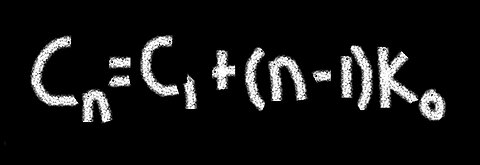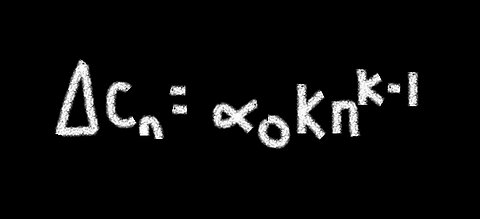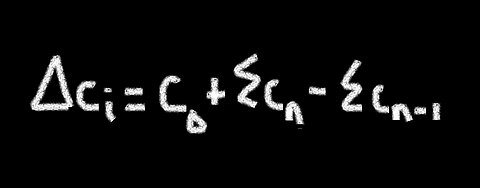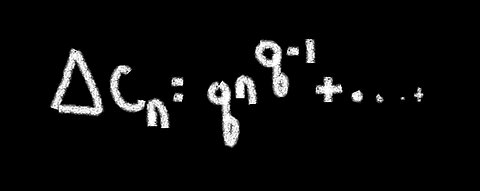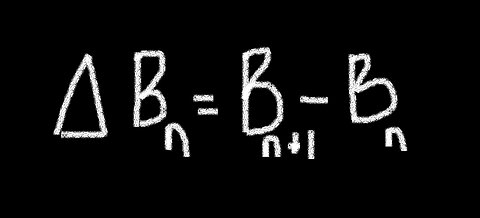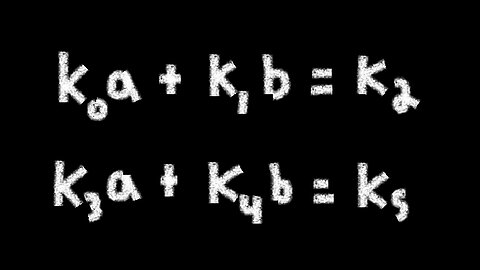
Sequences & Series
9 videos
Updated 1 year ago
Proof oriented foundational work in order to solve mathematical problems. Would be helpful to follow the published booklet on Sequences by S. Gelfand, M. Gerver, A. Kirillov, N. Konstantinov and A. Kushnirenko, 1969: problems 17 through 26 now LIVE! Strong focus on the Delta Difference operator. The problems are mentioned in the description boxes.
-
Find General Form of Series - System of Equations with Elimination Method
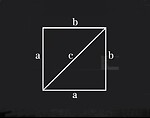 Side A Side BFind the general form of a series of perfect squares. By using a system of equations with the elimination method to solve for the coefficients, then solve for n, finally, check our work with the delta difference operation. Double checked our work from Wolfram. If you're wondering where the expressions came from to solve for coefficients of a cubic polynomial check a previous video: https://rumble.com/v5fxgjx-delta-difference-operation-find-formula-for-a-sequence-then-solve-for-n.html 6a, 12a+2b, 7a+3b+c, a+b+c+d, upon solving for (a) then plug into next expression to solve for (b), continue the procedure until (d) is solved. Sources: Kahn Academy YT Channel - Sal Gelfand, Gerver, Kirillov, Konstantinov and Kushnirenko - Sequences: 1969, problem 2637 views
Side A Side BFind the general form of a series of perfect squares. By using a system of equations with the elimination method to solve for the coefficients, then solve for n, finally, check our work with the delta difference operation. Double checked our work from Wolfram. If you're wondering where the expressions came from to solve for coefficients of a cubic polynomial check a previous video: https://rumble.com/v5fxgjx-delta-difference-operation-find-formula-for-a-sequence-then-solve-for-n.html 6a, 12a+2b, 7a+3b+c, a+b+c+d, upon solving for (a) then plug into next expression to solve for (b), continue the procedure until (d) is solved. Sources: Kahn Academy YT Channel - Sal Gelfand, Gerver, Kirillov, Konstantinov and Kushnirenko - Sequences: 1969, problem 2637 views -
Delta Difference Operation Defined over Polynomials of Multiple Terms
 Side A Side BIn a previous video we discussed the existence of a sequence, and upon taking the difference it equaled a monomial which is a polynomial with just one term. In this video we’re going to extend that idea to a polynomial of multiple terms just like the name conveys. The overall plan is...not one term but recover multiple terms from a hypothetical space. Sources: Gelfand, Gerver, Kirillov, Konstantinov and Kushnirenko - Sequences: 1969, problem 2538 views
Side A Side BIn a previous video we discussed the existence of a sequence, and upon taking the difference it equaled a monomial which is a polynomial with just one term. In this video we’re going to extend that idea to a polynomial of multiple terms just like the name conveys. The overall plan is...not one term but recover multiple terms from a hypothetical space. Sources: Gelfand, Gerver, Kirillov, Konstantinov and Kushnirenko - Sequences: 1969, problem 2538 views -
Delta Difference Operation, Find Formula for a Sequence - then Solve for n
 Side A Side BA culmination of work...after doing a difference operation on a sequence an (x) amount of times, what is the general term of the initial sequence? Then taking an unplanned detour, by applying what we know...find a general formula for a sequence and then solving for n. Viewers can skip to the application: @13:46 Also, taking a detour into the hypothetical...but then writing a recipe...proof of existence? Sources: Gelfand, Gerver, Kirillov, Konstantinov and Kushnirenko - Sequences: 1969, problem 2442 views
Side A Side BA culmination of work...after doing a difference operation on a sequence an (x) amount of times, what is the general term of the initial sequence? Then taking an unplanned detour, by applying what we know...find a general formula for a sequence and then solving for n. Viewers can skip to the application: @13:46 Also, taking a detour into the hypothetical...but then writing a recipe...proof of existence? Sources: Gelfand, Gerver, Kirillov, Konstantinov and Kushnirenko - Sequences: 1969, problem 2442 views -
Difference Operation. Condition: Alpha sub zero = Multiplicative Inverse of the Power
 Side A Side BAfter doing a difference operation on a sequence with its coefficient alpha sub zero equal to the general term’s power, what the result will be? With a short discussion of the Axiom of Choice...really what's stopping us from doing it that way? Sources: Gelfand, Gerver, Kirillov, Konstantinov and Kushnirenko - Sequences: 1969, problem 2356 views
Side A Side BAfter doing a difference operation on a sequence with its coefficient alpha sub zero equal to the general term’s power, what the result will be? With a short discussion of the Axiom of Choice...really what's stopping us from doing it that way? Sources: Gelfand, Gerver, Kirillov, Konstantinov and Kushnirenko - Sequences: 1969, problem 2356 views -
Delta Demo. The (Unofficial) Russian Doll Method in Action
 Side A Side BDoing the Difference operation (x) times on a (x + 1) sequence, what will this new sequence be equal to? Sources: Gelfand, Gerver, Kirillov, Konstantinov and Kushnirenko - Sequences: 1969, problem 2255 views
Side A Side BDoing the Difference operation (x) times on a (x + 1) sequence, what will this new sequence be equal to? Sources: Gelfand, Gerver, Kirillov, Konstantinov and Kushnirenko - Sequences: 1969, problem 2255 views -
The Triplet in General. Define Coefficient of Leading Term Proper
 Side A Side BAfter performing a Delta Difference operation in general, will make it possible for the coefficient of the leading term to be well defined. Which will begin a strong argument to find the nth term of a sequence of the form polynomial P(k). Oddly enough, the unofficial Triumvirate from the Italian Peninsula - G. Cardano, S. del Ferro and N. Tartaglia kicks it all off. Sources: Gelfand, Gerver, Kirillov, Konstantinov and Kushnirenko - Sequences: 1969, problem 2152 views 1 comment
Side A Side BAfter performing a Delta Difference operation in general, will make it possible for the coefficient of the leading term to be well defined. Which will begin a strong argument to find the nth term of a sequence of the form polynomial P(k). Oddly enough, the unofficial Triumvirate from the Italian Peninsula - G. Cardano, S. del Ferro and N. Tartaglia kicks it all off. Sources: Gelfand, Gerver, Kirillov, Konstantinov and Kushnirenko - Sequences: 1969, problem 2152 views 1 comment -
Delta Difference Operator. The (Unofficial) Cooper Method - Subtraction to find Results.
 Side A Side BUsing the Delta Difference Operator to understand the composition of sequences and series, should get the overall result of understanding polynomials in general. The first proof is our own which was to deal with a separate problem, however it can be re-written in a similar form as in problem 18. To clarify, there's enough information to deduce we can generalize for all sequences and series such as cubic. The subtraction method of Artist Floyd Cooper helps to clarify a difference operation. Sources: Gelfand, Gerver, Kirillov, Konstantinov and Kushnirenko - Sequences: 1969, problems 18 & 1943 views
Side A Side BUsing the Delta Difference Operator to understand the composition of sequences and series, should get the overall result of understanding polynomials in general. The first proof is our own which was to deal with a separate problem, however it can be re-written in a similar form as in problem 18. To clarify, there's enough information to deduce we can generalize for all sequences and series such as cubic. The subtraction method of Artist Floyd Cooper helps to clarify a difference operation. Sources: Gelfand, Gerver, Kirillov, Konstantinov and Kushnirenko - Sequences: 1969, problems 18 & 1943 views -
More Delta. The (Unofficial) Russian Doll Method - Find Leading Term
 Side A Side BUsing the Delta Difference Operator again, to understand the composition of sequences and series, will get a specific result of finding the leading term of a polynomial. To clarify, @ 06:00, just FOIL the expression as if (a+b)(a+b) then factor. It's as straight forward as a Russian doll of finding the least doll. Sources: Gelfand, Gerver, Kirillov, Konstantinov and Kushnirenko - Sequences: 1969, problem 2016 views
Side A Side BUsing the Delta Difference Operator again, to understand the composition of sequences and series, will get a specific result of finding the leading term of a polynomial. To clarify, @ 06:00, just FOIL the expression as if (a+b)(a+b) then factor. It's as straight forward as a Russian doll of finding the least doll. Sources: Gelfand, Gerver, Kirillov, Konstantinov and Kushnirenko - Sequences: 1969, problem 2016 views -
Gauss Method for sums - Delta Difference Operator to check
 Side A Side BIn this video average is Top! Going full average using Gauss Method for sums, then checking our work with the Delta Difference operator. Doing background work should "overall" help solve a Divisibility problem. Sources: Kahn Academy YT Channel Gelfand, Gerver, Kirillov, Konstantinov and Kushnirenko - Sequences: 1969, problem 1746 views 2 comments
Side A Side BIn this video average is Top! Going full average using Gauss Method for sums, then checking our work with the Delta Difference operator. Doing background work should "overall" help solve a Divisibility problem. Sources: Kahn Academy YT Channel Gelfand, Gerver, Kirillov, Konstantinov and Kushnirenko - Sequences: 1969, problem 1746 views 2 comments

